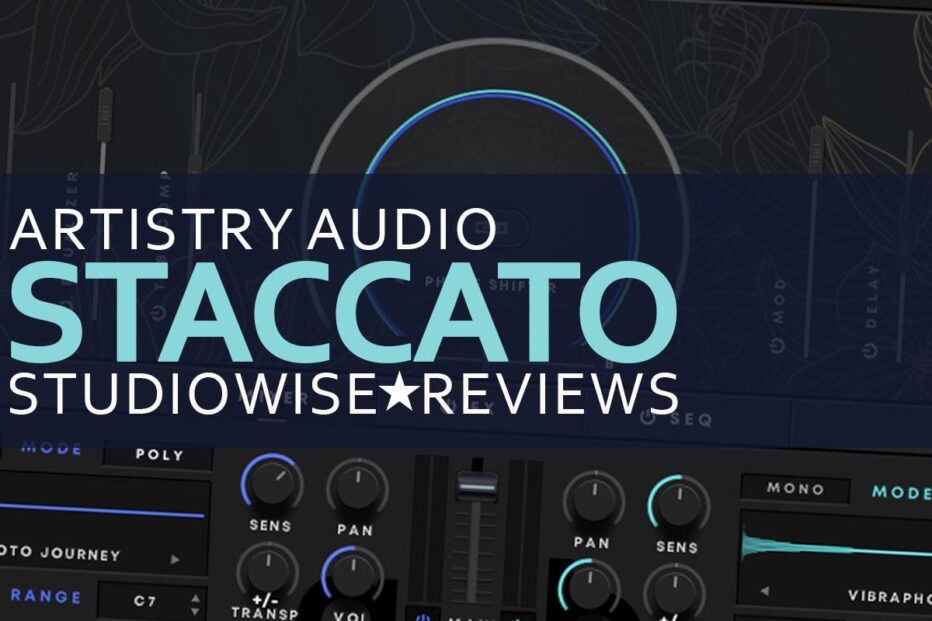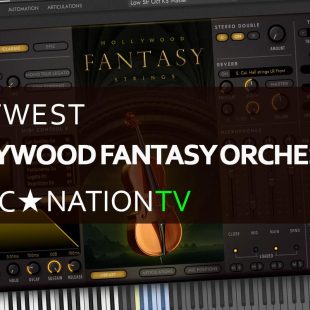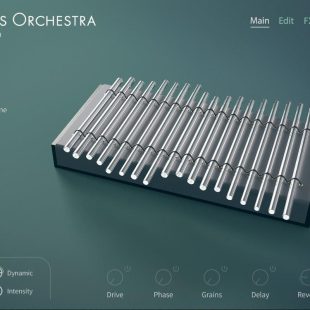Artistry Audio Staccato – Sonic Sorcery
Hello and welcome to our comprehensive review of Artistry Audio’s latest sample-morphing Kontakt instrument. The company boasts an impressive catalogue of high-quality Kontakt-based titles, and with the introduction of Staccato, they aim to push the creative envelope even further.
Artistry Audio Staccato review, June 2023.
Artistry Audio Staccato is an innovative Kontakt-based dual-engine sample playback instrument, designed to deliver a rich and analogue-inspired tone. With extensive synthesis controls, modulation options, and a diverse range of effects, Staccato offers a wide palette of creative possibilities.
The instrument features a dynamic layering system with advanced motion control and arpeggiators.
This already looks to be a compelling choice for music producers and composers, so let’s take a closer look at the software.
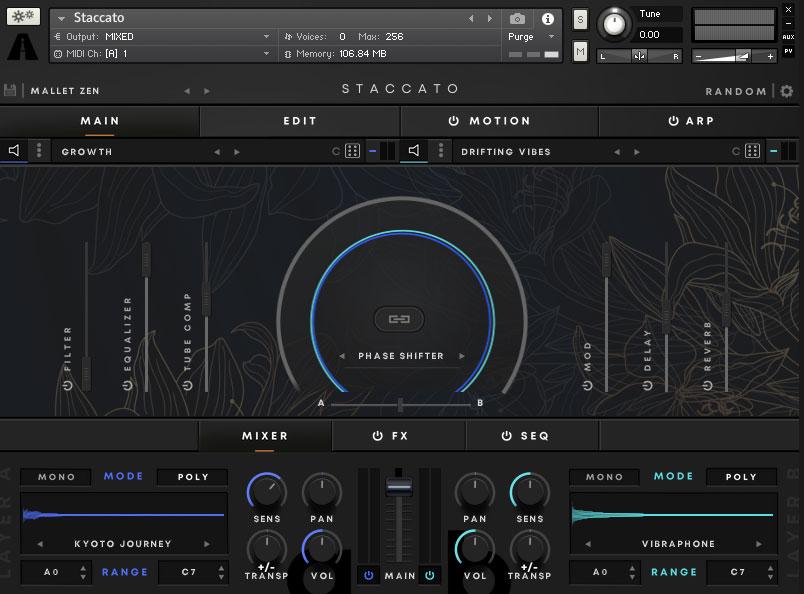
First Impressions
Staccato is a Kontakt-based dual-engine sample playback instrument with extensive synthesis controls, modulation, and FX.
I am certainly impressed by Staccato at first glance. The interface is crisp, clear, and contemporary. Although I quite like the dark aesthetics, it can be a little challenging to see the macro slider positions at a glance; using a more contrasting colour would make some elements stand out better. However, overall, Staccato looks classy and well-laid out.
Although the basic concept is simple enough – load a sample into each of its engines, add various effects, and presto create great noises – Staccato goes beyond that by incorporating layers that dynamically react with each other.
While its simplistic main page UI may appear straightforward at first glance, a deeper exploration uncovers a wealth of controls and functions, making it immediately clear that this is a complex and deep instrument.
Staccato offers two options for loading and playing core samples: the traditional sample playback engine and the more advanced granular option. Each option comes with full ADSR, filter control, and a wide range of effects.
The instrument features an easy-to-use mod matrix that allows for smooth manipulation of the sound output using a clever collection of motion controls. Additionally, a simple yet effective arpeggiator is included in the toolkit, making it a versatile tool for creating dynamic sound animations.
Getting Around The Interface
Upon installing and opening Staccato for the first time, the default preset showcases the instrument effectively and presents a wide range of its core capabilities. Right away, you can sense its full, very analogue-rich tone.
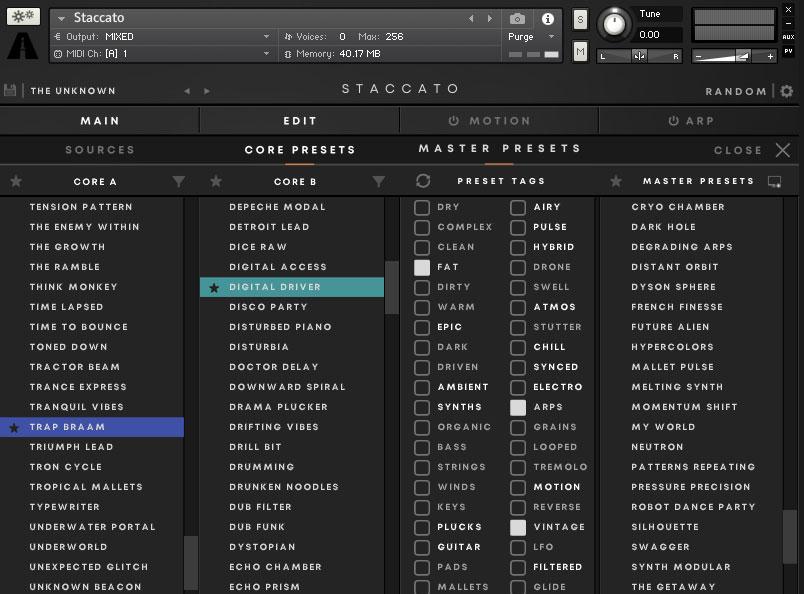
I am not familiar with Artisry Audios’ other titles, though Staccato looks to be very similar in operation to the company’s Monolith synth, so I would say if you are familiar with this you will be right at home with Staccato.
I found that I could comfortably achieve a good amount of control right from the front page, only needing to explore the instrument’s extended features if I wanted to experiment further.
There is a constant temptation to start tweaking and twiddling with functions just to see what happens. Once you do start exploring, it feels like proceeding down the rabbit hole, so to speak.
Getting started with patch exploring, Staccato’s browser is very well laid out and intuitive. You can load preset samples for each of the A or B engines, or choose a master preset for them both. A handy tagging system is included for filtering options, as well as a handy tag filter for the core presets.
I found the browser extremely useful when creating sounds from scratch as it’s possible to load just core sample sources without affecting your entire mix, or vice versa.
From what looks initially to be a quite simple workflow, the variations you can get from a single patch are amazing. When browsing the factory presets, even a patch that doesn’t immediately tweak your interest can be completely flipped around taking you in any number of musical directions due to the sheer number of modulation and randomisation functions on offer.
The flexibility of Staccato is impressive. From its frontend ‘easy mode’ large knob control to very deep and complex motion control and arpeggios, there is a lot for the tweak junkies to get their teeth stuck into.
How Does It Sound
Staccato has a very rich and wider sound thanks in part to its over-the-top use of arps, motion and FX. There is also a definite “analogness” to the sound in general, clearly some of the donor samples having originated in some tasty 70s synths at some stage.
As the title suggests the patches tend to be, or contain elements that are quite short in nature. Though there are plenty of your typical D50-style bells, Korg Wavestation-like mallets and plinky plonk patches, on the whole everything is quite synthy and leans towards atmospheric textures and drones.
Though Staccato is clearly marketed as “Synths In Motion”, I was expecting a lot more orchestral ostinato-style phrases and arpeggios and was disappointed in the lack of anything I would call actual “staccato”. The vast majority of the short patches are simply truncated ADSR synth sounds.
Happily, a major drawcard for Staccato is the ability to import your own samples so if you can’t find what you’re looking for you can simply bring your own samples to the party.
I found excellent results importing true staccato lines made from orchestral sample libraries which work incredibly well with the instrument’s organic FX system. I think Artistry Audio have missed a major trick here by not including some orchestral-themed samples in the factory banks. Perhaps something for a DLC expansion update in the future?
Staccato leans very heavily on FX which for the most part are fantastic, though I love mostly how the tube drive and distortion effects play such a large role in the sound.
With most factory patches, affecting the mod wheel brings mostly overdrive and boatloads of reverb, which is nice but very predictable after the first 10 or so presets.
The only trouble I found was the FX delays were not in sync with your DAW, so while the tempo matches the delays are usually wildly off-time resulting in more chaotic results as opposed to tight syncopation. This can be fixed by calculating the approximate sample tempo and matching your DAW bpm.
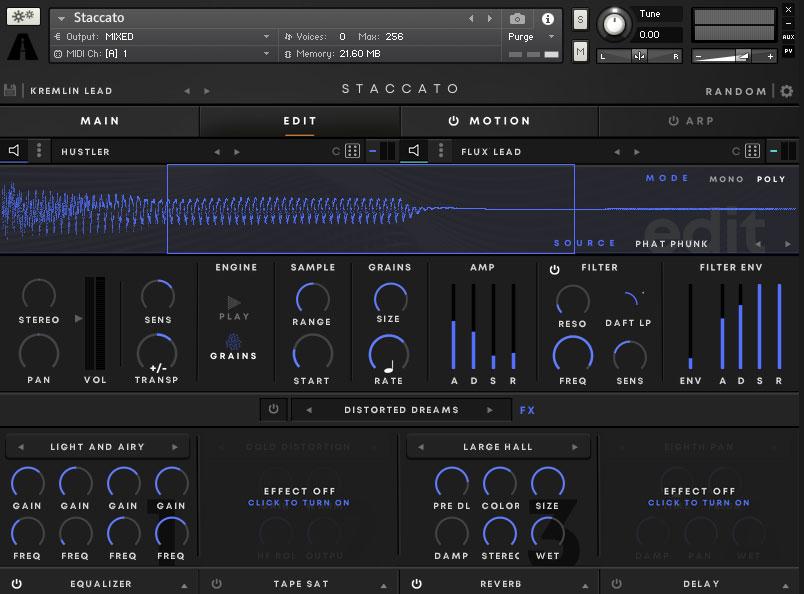
So Random
It doesn’t take long to notice the various randomisation dice icons dotted around the UI. One of the core tenets of Staccato is the use of these to randomise elements in the hope of stumbling on happy accidents. It’s a fun system we’ve seen employed on many other instruments and one that works perfectly with Staccato’s workflow.
Core to this system is the main random function at the top right of the screen. This allows for fine-tuning of elements to be affected and is a great way to spark some new ideas. Humorously, it’s even possible to randomise the randomiser with another small dice icon in this section.
Performance
Unfortunately, we encountered some significant hurdles with the instrument when it comes to DSP overheads which proved to be quite extreme, to say the least.
Though our 16gig i5 Windows test machine isn’t bleeding-edge technology by any measure, we feel it still represents a good platform that many users would still be running. I found Staccato a massive resource hog on our system, requiring 25% DSP just sitting idle, and usually around 55-70% in action depending on the number of notes played. We experienced DPS crackles on even the most simple patches.
The primary cause of this DSP drain seems to be the extensive use of effects which can certainly be helped by simply turning most of it off. While some patches have effects fundamental to the sound, I found that offloading certain effects to 3rd party plugins resulted in a more efficient use of processing power.
Additionally, the DSP drain appeared to be influenced by the choice of DAW. Popular platforms like Studio One, Reason, and Bitwig performed relatively poorly with Staccato, while Tracktion’s Waveform 12.5 showed significantly lower DSP overheads.
Running multiple instances of Staccato simultaneously proved challenging due to the high resource demands. To mitigate this, users can reduce effect overheads and bounce/freeze tracks as needed. However, I was somewhat disappointed with Staccato’s overall optimization, especially when compared to similar competitors in the market.
Edit control
As mentioned, Staccato features a twin-engine sample player with some impressive editing controls. The loaded samples playback zone can be stretched and reversed, with full ADSR amp and filter controls. A cool glide function transforms the sound completely.
The engine can be swapped to granular which adds a much more metallic tone to the sound, as well as further control of the rate and grain size.
A further four effects can be inserted into the bays below the sample editor, making for massive DSP-killing presets.
The dominant feature of the front main section is the large dial in the centre of the UI. This is a global control for each of the six mini-macro FX available to each side of it. Increasing the dial in turn affects each FX depending on its configuration. A simple but important concept as you don’t always have time for a deep dive when all you need is some inspiration.
The frontend FX are set in stone and can’t be changed, though a good amount of control for each means you can provide quite a large change to the sound simply by turning the dial. You could easily MIDI key bind any number of external 3rd party effects to also run from the mod wheel if you felt these six were cramping your style, but for my time testing Staccato these were more than enough to work with.
The handy Seq control slider allows for further automation of the FX macros and levels between A & B sample engines.
Motion Control
The motion control section of Staccato is quite complex and may require some reading and experimentation to fully grasp its functionality. This core feature of Staccato is responsible for creating its rather random and chaotic sound.
In simple terms, this section consists of a pair of effect motion controls that automatically fade between them using the pattern control in the middle. Each section can accommodate up to two devices, such as matrix sources, an arpeggiator, or LFO.
The top section contains the preset category and some preset states, while the bottom features an LFO preset section, which I found to be mostly effective depending on the instrument’s overall state. At times, the effect is prominent, while in other instances, it makes little difference.
While there is likely a method behind the apparent madness, I found this section to be somewhat experimental and unpredictable in practical use. Although understanding the intricacies and minute details could be beneficial, you can also have a lot of fun simply by pushing buttons, sliding faders, and twisting knobs to see what interesting outcomes occur.
Aroggios a plenty
Staccato features two simple yet effective arpeggiators, one for each of the sound engines. This arp section is quite interesting and intuitive to use, and truly adds a fully new dimension to the sound character.
The arp section is divided into six main sections or tracks which contain level faders controlling the effectiveness of the step in the chosen track. The tracks included being velocity, octave range, gate, a probability scale, stutter or repeater, and an overall transposer that acts like a pitch control.
While you can set each individual step level within the tracks, there is no way to affect the entire sequence, meaning you’ll need to either one-by-one change them manually or run your mouse across the range to draw in changes.
The only key bindable performance control is the step number dial, which is a shame. Being able to affect levels, step lengths and amounts in real-time would greatly elevate the live performance aspects of Staccato.
Also, I feel it’s missing some simple arp track macro controls for the front page where either directly controlling or assigning to the big knob would again add more functionality to the instrument.
The arpeggiator’s main role is to add further movement and unpredictability to the sound, which it accomplishes well. In comparison to the motion controls, the arp is simple to understand and relatively easy to manipulate.
Conclusion
Staccato is an excellent-sounding instrument with plenty of effective controls and experimental randomisation options. While there are a number of similar products on the market, Staccato’s true point of difference is in the motion controls, sample importing features and the beautiful mix of analogue richness and digital clarity that makes for an incredibly dynamic instrument.
Though Staccato is a deep and complex virtual instrument, at no stage did I feel overwhelmed or in desperate need to “Google” search answers to accomplish simple tasks, thanks in most part to the well-designed workflow.
I have some concerns about Staccatos DSP optimisation, it uses far more system resources than I would be willing to sacrifice in a larger songwriting project. You do have the option usually of freezing or bouncing down within your DAW, however, unless you drastically reduce the FX count you will need to live with the pops and crackles if you’re running even a modest multi-VSTi project.
This is more of an experimental instrument than a go-to for recreating a specific sound in your head. It is capable of a wide variety of sounds if you’re willing to invest time into the exploration process.
Staccato will immediately appeal to contemporary pop producers for its very on-trend sound, though I can see plenty of scope here for sound design, film, game and TV composition. I feel Staccato is more of an experimental instrument than a go-to for recreating a specific sound in your head. It is capable of a wide variety of sounds if you’re willing to invest time into the exploration process, and due to its morphing and randomisation function any sound you’re likely to create will be unique and fresh.
Staccato is a powerful instrument that requires an equally powerful system to fully utilise. Whether or not these demands fit in with your current system is a consideration but at the end of the day, this is one of the best sounding and creative Kontakt instruments available.
Full details on Artistry Audios site www.artistryaudio.com

Like the review? Shout us a cup of coffee!

